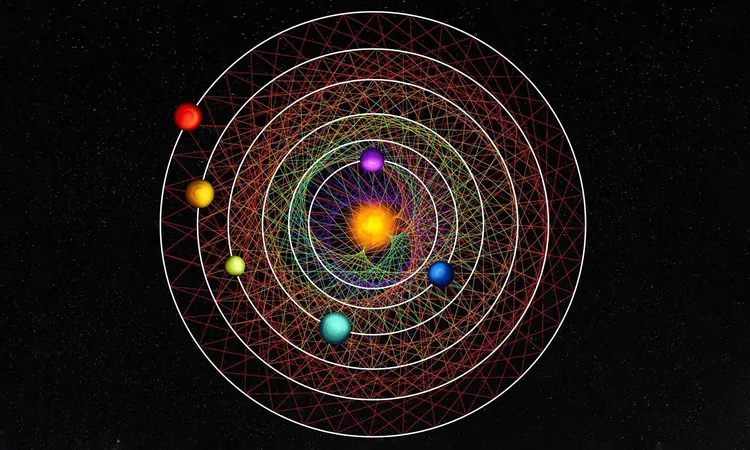
Astronomers Discover a Remarkable Six-Planet System Orbiting in Perfect Harmony!
2025-01-10
Author: Jia
Introduction
Researchers have unveiled a groundbreaking discovery: a six-planet system moving in astonishingly synchronized orbits around a single star, designated HD110067. Located roughly 100 light-years away in the constellation Coma Berenices, this star and its unique planetary configuration provide new insights into the dynamics of planetary systems.
Resonant System Overview
Dubbed a 'resonant' system, HD110067's planets maintain their orbital periods in a fixed ratio for eons—perhaps millions or even billions of years—creating a phenomenon that resembles a finely tuned musical composition. These synchronized orbits offer astronomers a fresh perspective on how certain stars can maintain a stable 'family' of planets through the ages.
Discovery Process
The discovery was spearheaded by Rafael Luque and his team at the University of Chicago. Utilizing data from NASA’s Transiting Exoplanet Survey Satellite (TESS) and the European Space Agency’s CHaracterizing ExOPlanet Satellite (Cheops), scientists first noticed unusual dips in brightness indicating planetary transits. The result? A rare chain of six sub-Neptune sized planets closely orbiting their host star.
Significance of Sub-Neptunes
'This discovery represents a benchmark for understanding sub-Neptunes—some of the most prevalent planets beyond our solar system,' Luque stated. He emphasizes the importance of studying their formation, evolution, and potential habitability, such as the presence of liquid water on their surfaces.
Characteristics of Sub-Neptunes
Sub-Neptunes are intriguing worlds, falling between Earth and Neptune in size, and can vary significantly in their physical characteristics—from dense, rocky surfaces to thick gaseous envelopes. The ability to observe this harmonious arrangement lends credence to theories about how resonant systems maintain stability over cosmic timescales.
Rarity of Resonant Systems
Resonant systems like HD110067 are relatively rare; only about one percent of multi-planet systems achieve this delicate balance. External dynamics—like the interplay with larger planets or close stellar neighbors—often disrupt these synchronized orbits. Fortunately for HD110067, the absence of larger gravitational influences has allowed its six sub-Neptunes to remain in alignment since their inception.
Future Research Directions
Understanding this stable system is crucial for astronomers piecing together the larger puzzle of planetary formation. By analyzing each planet's mass and density, researchers aim to unravel the materials that constitute these distant worlds—insights that could provide clues about their potential to harbor life.
Ongoing Monitoring
Researchers plan to closely monitor HD110067 in the coming years with advanced instrumentation on ground-based telescopes and future space observatories. Enhanced measurement techniques may reveal more about the interior structures of these planets and whether any possess conditions suitable for water retention.
Wider Implications
The implications of this discovery are vast, offering clues not only about this particular system but also about the processes shaping planetary systems across the galaxy. As we continue to explore our cosmic neighborhood, the question remains: how many other resonant systems are out there, waiting to be discovered?
Conclusion
This research has been detailed in a recent issue of the prestigious journal Nature, inviting further examination and exploration into the enigmatic world of exoplanets. Stay tuned for more updates on this exciting frontier of astronomy, where every breakthrough unveils new mysteries!


 Brasil (PT)
Brasil (PT)
 Canada (EN)
Canada (EN)
 Chile (ES)
Chile (ES)
 Česko (CS)
Česko (CS)
 대한민국 (KO)
대한민국 (KO)
 España (ES)
España (ES)
 France (FR)
France (FR)
 Hong Kong (EN)
Hong Kong (EN)
 Italia (IT)
Italia (IT)
 日本 (JA)
日本 (JA)
 Magyarország (HU)
Magyarország (HU)
 Norge (NO)
Norge (NO)
 Polska (PL)
Polska (PL)
 Schweiz (DE)
Schweiz (DE)
 Singapore (EN)
Singapore (EN)
 Sverige (SV)
Sverige (SV)
 Suomi (FI)
Suomi (FI)
 Türkiye (TR)
Türkiye (TR)
 الإمارات العربية المتحدة (AR)
الإمارات العربية المتحدة (AR)